
Ernest Howard Shepard was an English artist and book illustrator. He is known especially for illustrations of the anthropomorphic animal and soft toy characters in The Wind in the Willows and Winnie-the-Pooh.

Christopher Robin is a character created by A. A. Milne, based on his son Christopher Robin Milne. The character appears in the author's popular books of poetry and Winnie-the-Pooh stories, and has subsequently appeared in various Disney adaptations of the Pooh stories.
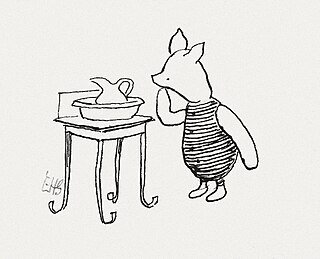
Piglet is a fictional character from A. A. Milne's Winnie-the-Pooh books. Piglet is Winnie‑the‑Pooh's closest friend amongst all the toys and animals featured in the stories. Although he is a "Very Small Animal" of a generally timid disposition, he tries to be brave and on occasion conquers his fears.

Roo is a fictional character created in 1926 by A. A. Milne and first featured in the book Winnie-the-Pooh. He is a young kangaroo and his mother is Kanga. Like most other Pooh characters, Roo is based on a stuffed toy animal that belonged to Milne's son, Christopher Robin Milne. Though stuffed, Roo was lost in the 1930s in an apple orchard somewhere in Sussex.

Winnie-the-Pooh is a 1926 children's book by English author A. A. Milne and English illustrator E. H. Shepard. The book is set in the fictional Hundred Acre Wood, with a collection of short stories following the adventures of an anthropomorphic teddy bear, Winnie-the-Pooh, and his friends Christopher Robin, Piglet, Eeyore, Owl, Rabbit, Kanga, and Roo. It is the first of two story collections by Milne about Winnie-the-Pooh, the second being The House at Pooh Corner (1928). Milne and Shepard collaborated previously for English humour magazine Punch, and in 1924 created When We Were Very Young, a poetry collection. Among the characters in the poetry book was a teddy bear Shepard modelled after his son's toy. Following this, Shepard encouraged Milne to write about his son Christopher Robin Milne's toys, and so they became the inspiration for the characters in Winnie-the-Pooh.
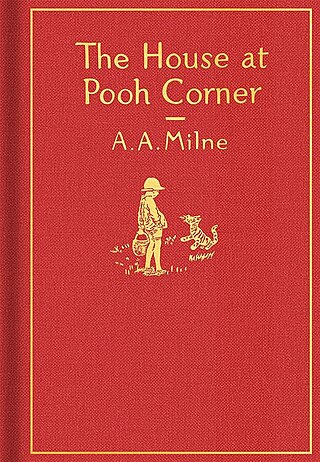
The House at Pooh Corner is a 1928 children's book by A. A. Milne and illustrated by E. H. Shepard. This book is the second novel, and final one by Milne, to feature Winnie-the-Pooh and his world. The book is also notable for introducing the character Tigger. The book's exact date of publication is unknown beyond the year 1928, although several sources indicate the date of October 11.

Christopher Robin Milne was an English author and bookseller and the only child of author A. A. Milne. As a child, he was the basis of the character Christopher Robin in his father's Winnie-the-Pooh stories and in two books of poems.

The Many Adventures of Winnie the Pooh is a 1977 American animated musical anthology comedy film produced by Walt Disney Productions and distributed by Buena Vista Distribution. It was first released on a double bill with The Littlest Horse Thieves on March 11, 1977.
Ann Thwaite is a British writer who is the author of five major biographies. AA Milne: His Life was the Whitbread Biography of the Year, 1990. Edmund Gosse: A Literary Landscape was described by John Carey as "magnificent - one of the finest literary biographies of our time". Glimpses of the Wonderful about the life of Edmund Gosse's father, Philip Henry Gosse, was picked out by D. J. Taylor in The Independent as one of the "Ten Best Biographies" ever. Her biography of Frances Hodgson Burnett was originally published as Waiting for the Party (1974) and reissued in 2020 with the title Beyond the Secret Garden, with a foreword by Jacqueline Wilson. Emily Tennyson, The Poet's Wife (1996) was reissued by Faber Finds for the Tennyson bicentenary in 2009.

The Hundred Acre Wood is a part of the fictional land inhabited by Winnie-the-Pooh and his friends in the Winnie-the-Pooh series of children's stories by author A. A. Milne. The wood is visited regularly by the young boy Christopher Robin, who accompanies Pooh and company on their many adventures.

The Book of Pooh is an American children's television series that aired on the Playhouse Disney block on Disney Channel. It is the third television series to feature the characters from the Disney franchise based on A. A. Milne's works; the other two were the live action Welcome to Pooh Corner and the animated The New Adventures of Winnie the Pooh which ran from 1988 to 1991. It premiered on January 22, 2001 and completed its run on July 8, 2003. The show is produced by Shadow Projects. Walt Disney Pictures released the first of two films, a direct-to-video spin-off film based on the puppetry television series titled The Book of Pooh: Stories from the Heart in 2001.

Winnipeg, or Winnie, was the name given to a female black bear that lived at London Zoo from 1915 until her death in 1934. Rescued by cavalry veterinarian Harry Colebourn, Winnie is best-remembered for inspiring the name of A. A. Milne and E. H. Shepard's character, Winnie-the-Pooh.

Winnie the Pooh is a fictional bear and the main character in Disney's Winnie the Pooh franchise, based on the character Winnie-the-Pooh created by English author A. A. Milne and English artist and book illustrator E. H. Shepard, being one of the most popular characters adapted for film and television by The Walt Disney Company. Disney first received certain licensing rights to the Winnie-the-Pooh stories, characters, and trademarks from Stephen Slesinger, Inc. and the estate of A. A. Milne in 1961. Winnie the Pooh is one of the most popular characters adapted for film and one of Disney's most popular characters, especially in terms of merchandising.

Harry D. Colebourn was a Canadian veterinarian and soldier with the Royal Canadian Army Veterinary Corps best known for donating a bear cub named "Winnie" to London Zoo. Winnie later inspired the creation of A. A. Milne's famous children's book character Winnie-the-Pooh.

Winnie-the-Pooh is a fictional anthropomorphic teddy bear created by English author A. A. Milne and English illustrator E. H. Shepard. Winnie-the-Pooh first appeared by name in a children's story commissioned by London's Evening News for Christmas Eve 1925. The character is inspired by a stuffed toy that Milne had bought for his son Christopher Robin in Harrods department store, and a bear they had viewed at London Zoo.

Mark Burgess is best known as an English author and illustrator of children's literature. He has illustrated books by Tony Bradman and Martin Waddell. Among his most recent assignments, he illustrated Return to the Hundred Acre Wood, the authorized sequel of Winnie-the-Pooh.
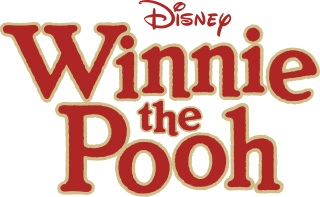
Winnie the Pooh is a media franchise produced by The Walt Disney Company, based on A. A. Milne and E. H. Shepard's stories featuring Winnie-the-Pooh. It started in 1966 with the theatrical release of the short Winnie the Pooh and the Honey Tree.

Christopher Robin is a 2018 American live-action/animated fantasy comedy drama film directed by Marc Forster from a screenplay by Alex Ross Perry, Tom McCarthy, and Allison Schroeder, based on a story by Greg Brooker and Mark Steven Johnson. The film is inspired by the children's book series Winnie-the-Pooh by A. A. Milne and E. H. Shepard, and is a live-action/CGI follow-up to the Disney franchise of the same name. The film stars Ewan McGregor as the title character, alongside Hayley Atwell as his wife Evelyn, with the voices of Jim Cummings, Nick Mohammed as Piglet, and Brad Garrett. The story follows Christopher Robin, now an adult, who has lost his sense of imagination, only to be reunited with his childhood friend Winnie the Pooh, whom he must escort back to the Hundred Acre Wood to find his friends.
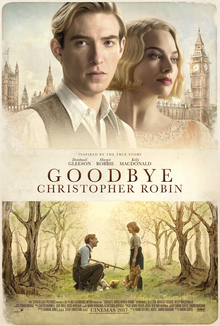
Goodbye Christopher Robin is a 2017 British biographical drama film about the lives of Winnie-the-Pooh creator A. A. Milne and his family, especially his son Christopher Robin. It was directed by Simon Curtis and written by Frank Cottrell-Boyce and Simon Vaughan, and stars Domhnall Gleeson, Margot Robbie, and Kelly Macdonald. The film premiered in the United Kingdom on 29 September 2017. It received mixed reviews from critics and grossed $7.2 million at the box office.
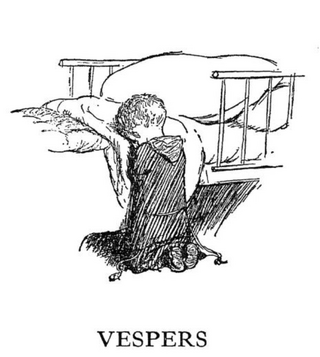
"Vespers" is a poem by the British author A.A. Milne, first published in 1923 by the American magazine Vanity Fair, and later included in the 1924 book of Milne's poems When We Were Very Young when it was accompanied by two illustrations by E.H. Shephard. It was written about the "Christopher Robin" persona of Milne's son Christopher Robin Milne. It predates the creation of Winnie-the-Pooh.


























